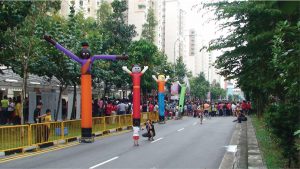Multiculturalism and the politics of the spectacle in global Singapore
July 21, 2020

Racial Harmony Day in Singapore is observed on 21 July each year in the spirit of celebrating its racially diverse and harmonious population. Activities held on this day are largely organised by schools and grassroots groups, and typically involve traditional costumes, games, and delicacies from Singapore’s four ethnic races. Notably, Racial Harmony Day is also held in commemoration of Singapore’s 1964 race riots.
Despite Singapore’s ostensible success with racial and religious harmony, Associate Professor Daniel P.S. Goh (NUS Department of Sociology) adds a critical perspective to Singapore’s multicultural fabric in his essay ‘Multicultural carnivals and the politics of the spectacle in global Singapore’ (Inter-Asia Cultural Studies, 2013). Through an examination of Singapore’s multicultural carnivals vis-à-vis the nation’s backdrop of globalisation and progress, A/P Goh frames these multicultural sites as spectacles that engage with emergent racial-class fissures.
As contextualized by the essay, multiculturalism in Singapore is governed closely by its paternalistic government, and monitored and managed closely through the state’s multiracial nation-building program and ascriptive policies. Significantly, with an increasingly globalised and cosmopolitan Singapore, A/P Goh raises the issue of a growing class and cultural divide between ‘cosmopolitans’ and ‘heartlanders’. As a result, multiracialism has assumed a national function of anchoring its globalised middle class in Singapore’s ethnic heritage, and also in advancing the nation as a global city.
Going further, the bulk of the essay adopts a unique analysis of two multicultural carnivals in Singapore: The first, the annual Racial Harmony parade and carnivals organised by local authorities in Singapore’s public housing estates; the second, a 2007 carnival called Raised, organised in Little India and held in conversation with male foreign workers and the public on migrant labour issues. In both, A/P Goh is concerned with the manner in which the spectacle of such multicultural carnivals have become commodities used to bolster the global city’s promise of fulfilled dreams and hopes.
Read the full article here.
